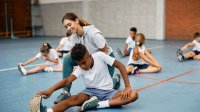SEL Possibilities in Physical Education
Physical education teaches relationship-building and self-management skills, making it a natural for social and emotional learning.
Your content has been saved!
Go to My Saved Content.Social and emotional learning (SEL) has become one of the fastest-growing topics in the world of education. As a result, school districts all across the country are asking, “What does SEL look like in our schools, and how can we improve it?” While the search for SEL opportunities continues, schools should consider the integral role that physical education class can play in the long-term goal of social and emotional learning.
Outdated stereotypes of dodgeball and kickball have plagued physical education (PE) for years. But PE is far more than just rolling out the ball for kids to play and mess around. Instead, physical education today offers a wide variety of fitness, health, and wellness skills that help students to prepare for long-term healthy lives. And beyond developing cardiovascular endurance and muscular strength, PE is a subject that supports the full picture of healthy lives.
As a result, physical education offers a valuable opportunity to impact all areas of student development—physical, mental, social, and emotional. Better yet, all of these are packed into the national standards for physical education.
Physical Education’s Social and Emotional Standard
Almost every subject presents an opportunity to find unique ways to incorporate social and emotional learning into class. But not every subject has it written directly into its national standards. Physical education does. Within the five national physical education standards defined by Shape America, standard number four states, “The physically literate individual exhibits responsible personal and social behavior that respects self and others.”
Many physical education teachers proudly boast of this as the SEL standard. If we take a closer look, the standard directly taps into CASEL and what they define as the five core competencies of SEL:
- Self-awareness
- Self-management
- Responsible decision-making
- Relationship skills
- Social awareness
Using these five core competencies, physical education departments can evaluate and label how they currently offer social and emotional learning throughout their program and where they can potentially improve.
The 5 Core Competencies in Action
To help illustrate the connection between SEL and PE, let’s use Canton High School in Massachusetts as an example.
Canton was recently featured in a national video spotlight for their comprehensive approach to physical education. Because it’s a nationally recognized physical education program, let’s find an example of each of the five core competencies in action.
1. Self-awareness (developing interests and a sense of purpose). At Canton High School, the physical education department has evolved its curriculum from ninth to 12th grade to promote self-awareness. Instead of a games/sports-focused ninth- and 10th-grade curriculum, the school offers classes focusing on skill development, personal fitness, and health. The shift fosters a safe and nurturing environment where students can develop personal interests and then begin to make more individual choices in 11th- and 12th-grade electives.
2. Self-management (exhibiting self-discipline and self-motivation; setting personal and collective goals). Every student in the high school's sophomore personal wellness class (featured throughout the video) goes through an introduction-to-fitness course. In this course, students set personal goals on how to improve their general fitness and are guided through ways to motivate themselves through challenging workouts and activities. All of this is done using an individualized approach so that every student has a chance to succeed.
3. Responsible decision-making (learning how to make a reasoned judgment after analyzing information, data, and facts). Students also navigate cognitive nutrition lessons in the same sophomore personal wellness class. Teachers utilize a curriculum that takes an informative, not prescriptive, approach to nutrition. After students get all the facts and information, they have to make their own decisions on personal nutrition that work best for them and their daily lives.
4. Relationship skills (practice teamwork and collaborative problem-solving). As a culmination of the personal wellness class, students form small groups and are tasked with leading a class. The teams must collaborate to find lesson materials, plan an entire lesson, and execute it with a larger group. After teaching the class, the leaders must practice empathy and patience when introducing a new topic to other students.
5. Social awareness (understanding and expressing gratitude). While much of physical education is activity based, Canton has recently implemented a mindfulness curriculum into class. These lessons guide students through mindfulness exercises and practices that include specific sessions on gratitude, heartfulness, communication, and other social awareness concepts. While this is a more obvious SEL connection, it’s one that physical education is adopting in more and more schools.
Putting PE and SEL on Display
As the above example shows, social and emotional learning is not hard to find in physical education class. It might be intimidating to put your PE curriculum under the SEL microscope, but you might be surprised by what you find. As school districts feel the added pressure of incorporating SEL, they should turn to the physical education teachers who have tirelessly worked to develop curriculum and lesson plans like the ones I describe here.
By doing so, we can also make a case for even more emphasis on and investment in SEL in physical education and schools. It all starts with advocating and highlighting that physical education plays a key role in social and emotional learning for our students.

